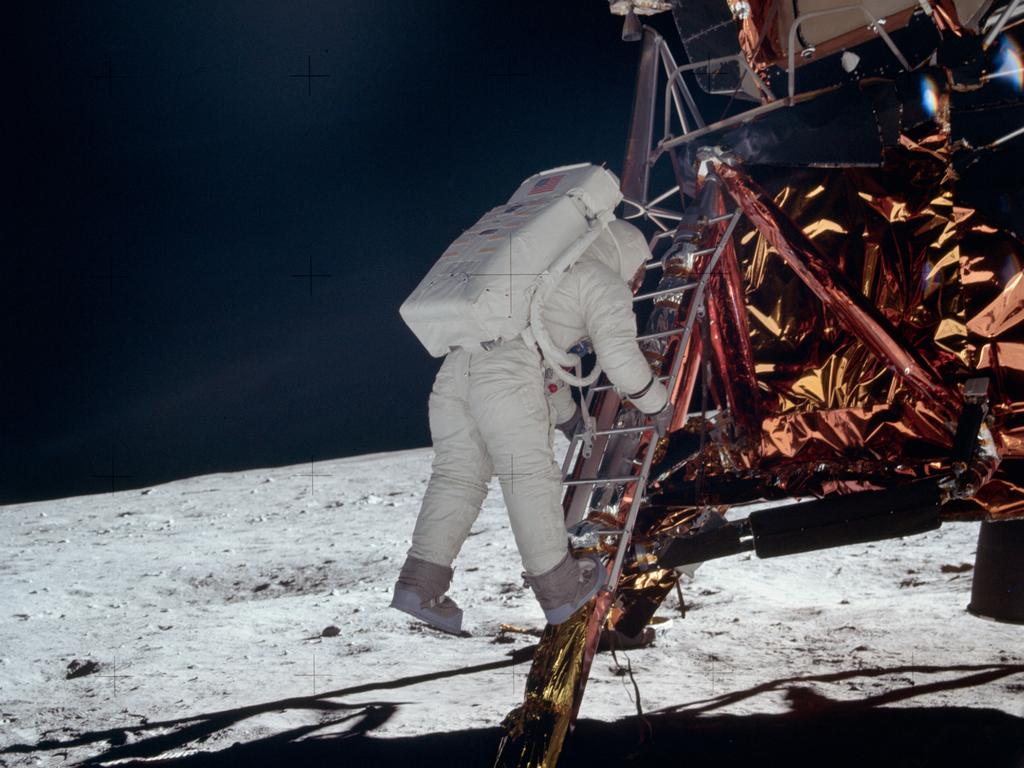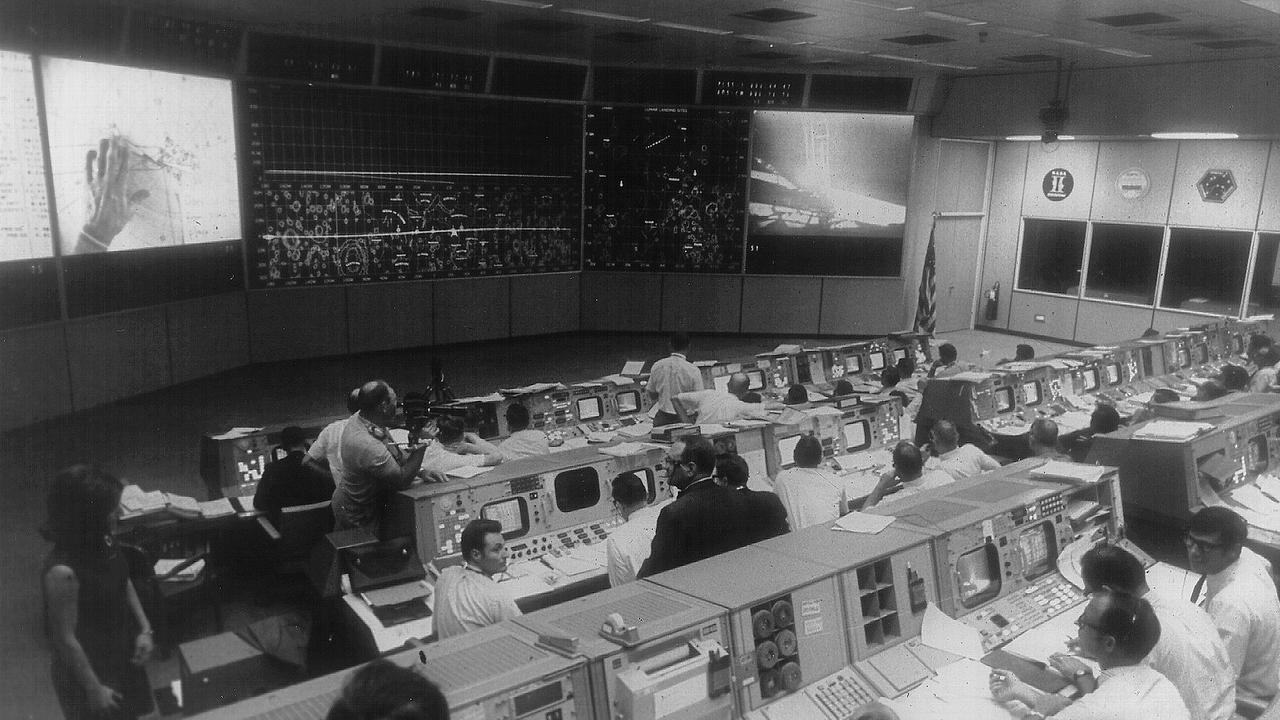Moon landing 50th anniversary: Apollo mission mistake that cost humans landing on Mars decades ago
It’s been 50 years since Apollo 11, and a NASA engineer has revealed why humans haven’t been back to the moon or visited Mars.
It’s been half a century and the words still ignite goosebumps: “That’s one small step for man, one giant leap for mankind.”
On July 20, 1969, Neil Armstrong stepped off a ladder onto the moon’s surface and declared that famous phrase, as more than half a billion people tuned in across the globe in an astronomical feat that changed the world forever.
The Apollo Project, which was launched in 1963 and was a goal set by then US president John F Kennedy, was designed to land humans on the moon and bring them safely back to Earth.
Six of the missions (Apollos 11, 12, 14, 15, 16, and 17) achieved this goal. Apollos 7 and 9 were Earth orbiting missions to test the command and lunar modules and did not return lunar data.
Apollos 8 and 10 tested various components while orbiting the moon and returned photography of the lunar surface.
Apollo 13 did not land on the moon due to a malfunction but returned photographs.
Apollo 1 in 1967 was the biggest failure after a cabin fire killed the crew of three during a prelaunch test.
The six missions that landed on the moon returned a wealth of scientific data and almost 400 kilograms of lunar samples.
But it was Apollo 11 that garnered extreme attention.
RELATED: Mysterious large mass on the Moon puzzles scientists
RELATED: NASA announces plan to rush 2019 Moon mission
RELATED: Study finds Earth’s moon is still geologically active
Launching from Cape Kennedy on July 16, 1969, it carried Commander Armstrong, command module pilot Michael Collins and lunar module pilot Edwin “Buzz” Aldrin into an initial Earth orbit of 114 by 116 miles.
It was a moment for everyone. A gripping, nailbiting, glorious moment. But to those who had dedicated their lives to researching space, it was a lot more than just a moment.
We haven’t been back to the moon since the program ended in 1972. So, why not?
Award-winning filmmaker Tom Jennings, who made National Geographic’s commemorative documentary Apollo: Missions To The Moon — which premieres on Foxtel on Monday night — told news.com.au the public hype around the program died, thus so did funding.


“When Apollo 11 landed on the moon the entire world stopped,” Jennings said.
“Apollo 8 people remember because it was the first time Earth was photographed rising above the horizon of the moon, and it was the first time anyone had gone from the US, outside the gravitational bounds of earth, around the moon and back home.
“Then when Apollo 12 and Apollo 13 came around, the amount of coverage it was getting was minimal compared to Apollo 11 when everyone tuned in to watch the first guys walk on the moon ... then it was kind of like, been there, done that.
“There were a lot of issues going on in the late ’60s and ’70s. The Vietnam War was going on, there was social upheaval at the time so people were like, ‘Why would we go there again?’
“Politicians hear that, so budgets were dramatically cut. Then Apollo 13 happened and they almost got killed in space. There were all these fears, so NASA went back to servicing satellites.
“I think only now it’s taken a new younger generation of people, with Elon Musk and Jeff Bezos, to get people looking at space again. And now we’re maybe ready to try it again.”


And while tech entrepreneurs like Mr Musk are making the topic newsworthy again, what with shooting Tesla cars into space, Jennings spoke to numerous researchers during the making of his doco who claimed halting the Apollo missions was detrimental in terms of further research and, more interestingly, humans finally reaching the red planet: Mars.
“If we kept going with Apollo, we would’ve been on Mars 30 years ago,” Jennings says he was told by a Texan woman named Frances “Poppy” Northcutt, who was an engineer for the technical staff on NASA’s Apollo Program during the space race.
She was also the first female engineer to work in NASA’s Mission Control during Apollo 8.
“I asked her about Mars and she said if Apollo had evolved instead of just becoming a space shuttle, that we would've been on Mars by now,” Jennings said.
“Poppy felt like they had laid the groundwork, and they should have kept going out instead of just servicing the stratosphere of Earth.
“I was literally speechless. It felt like a tragedy.”
A human mission to Mars has been the goal of space programs for many years as well as being a subject of modern science fiction. The biggest question: Is there hidden alien life forms on the red planet?
And if so, what are they?
The largest limiting factor for sending humans to Mars is funding. The estimated cost is roughly $US500 billion — yes, half a trillion dollars — though the actual costs would undoubtedly skyrocket beyond that.
On top of money, there are health threats (cosmic rays and radiation), psychological impacts and a very real threat of life-support equipment failing.
Mars has only ever been explored by spacecraft. Up to now, the success rate at the red planet has been only 40 per cent, counting every attempted fly-by, orbital flight and landing by the US, Russia and other countries since 1960.


Five more missions are in the late stages of development and fabrication and will be launched between 2020 and 2021. These include the ExoMars Rosalind Franklin rover by Russia and the European Space Agency, NASA’s Mars 2020 rover, the 2020 Chinese Mars Mission, the Hope Mars Mission by the United Arab Emirates and India’s Mars Orbiter Mission 2.
Mr Musk has previously detailed plans for his company SpaceX to put humans on Mars by 2024, but the likelihood of this happening is dismal.
He also believes he could send the first two cargo ships there by 2020.
US aerospace giant Lockheed Martin’s plans for a mission to Mars include a single-stage spacecraft designed to ferry astronauts between the orbiting base camp and the planet’s surface. It believes it could launch a Mars mission within the next decade.
There’s definitely enough ambition out there, but it’s pretty sobering to think we could’ve been a lot more ahead than we are now.
Apollo: Missions To The Moon is a two-hour feature documentary, executive produced by Jennings, who is also known for Diana: In Her Own Words.
It weaves together more than 500 hours of footage, 800 hours of audio and 10,000 photos.
The moon landing is a competitive topic, but Jennings has used his famous style of filmmaking for this documentary.
“There’s no narrator and no modern-day interviews. That is on purpose,” Jennings said.
“The idea is we take all of these archives, both from inside NASA and news footage, documentary footage made at the time, and put it together in a way that feels very new and fresh.
“It’s as if viewers are in the living room in the ’60s. We did it in a way that makes it immersive. You’re waiting for the narrator to come in and save it, and he never shows up.”
It also features newly transferred film and never-before-heard audio of the groundbreaking moments from the moon landing.
Apollo: #MissionsToTheMoon shares rare NASA footage and interviews that capture the mission to land Americans on the moon. Here's the story about how this documentary came together. pic.twitter.com/bqCOKD1Clo
— Nat Geo Channel (@NatGeoChannel) July 6, 2019
Apollo: Missions To The Moon premieres on Monday, July 15 at 8.30pm on National Geographic
Originally published as Moon landing 50th anniversary: Apollo mission mistake that cost humans landing on Mars decades ago



